Web siteniz büyüdükçe, farklı görevleri yönetmeye yardımcı olması için ekip üyelerini veya yüklenicileri işe almanız gerekebilir. İster gönderi yazmak, ister ayarları değiştirmek veya müşteri siparişlerini yönetmek olsun, herkesin aynı düzeyde erişime ihtiyacı yoktur.
Her yeni kullanıcının tam yönetici haklarına sahip olması gerektiğini varsaymak kolaydır, ancak bu riskli olabilir. Birçok site sahibi, çok fazla erişimin yanlışlıkla değişikliklere veya daha kötüsü güvenlik sorunlarına yol açabileceğini zor yoldan öğrendi.
Birisi sadece ön bahçeye erişmek isterken tüm evinizin anahtarlarını teslim etmek gibi.
Neyse ki WordPress, her bir kişinin sitenizde neler yapabileceğini kontrol etmenizi sağlayan yerleşik kullanıcı rolleriyle birlikte gelir. Blog yazıları yazmaktan eklentileri yönetmeye kadar, kimin neye erişebileceğine karar verebilirsiniz.
Bu kılavuzda, WordPress kullanıcı rollerini ve izinlerini inceleyeceğiz, böylece her kullanıcıya doğru rolü güvenle atayabilirsiniz.
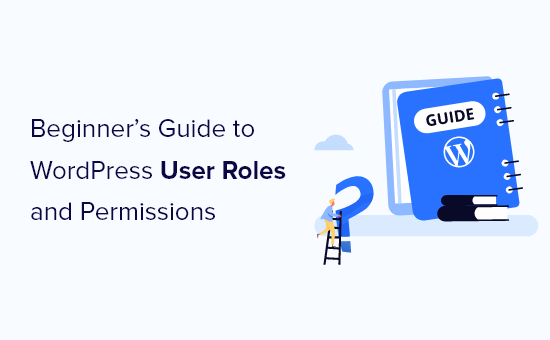
WordPress Kullanıcı Rolleri ve İzinleri Nelerdir?
WordPress sitenizi bir ev gibi düşünün. Herkesin her odanın anahtarına ihtiyacı yoktur. Bazı kişiler yalnızca ön kapıyı açabilirken, diğerlerinin mutfağa veya ofise erişmesi gerekebilir.
WordPress kullanıcı rolleri ve izinleri, sitenizde kimin ne yapabileceğine karar vermenize yardımcı olur. Web siteniz üzerinde kontrol sahibi olmanızı sağlar ve sitenizi yanlışlıkla yapılan değişikliklere veya güvenlik risklerine karşı güvende tutar. Bunları akıllıca kullanmak, net sınırlar belirlemek gibidir; herkes gereksiz riskler olmadan doğru erişime sahip olur.
Sitenize birden fazla kullanıcı ekleyebilir, hatta yeni ziyaretçilerin açık kayıt yoluyla kaydolmasına izin verebilirsiniz. Ancak erişimi devretmeden önce doğru rolü atamak önemlidir.
Her kullanıcı rolü, bir kişinin hangi eylemleri gerçekleştirebileceğini tanımlayan bir dizi izinle birlikte gelir. Bazı roller kullanıcıların gönderi yayınlamasına izin verirken, diğerleri yalnızca içeriği okuyabilir veya ayarları yönetebilir.
WordPress beş varsayılan kullanıcı rolü içerir:
Bunları karşılaştırmak için hızlı bir yola mı ihtiyacınız var? Aşağıdaki infografiğe göz atın:
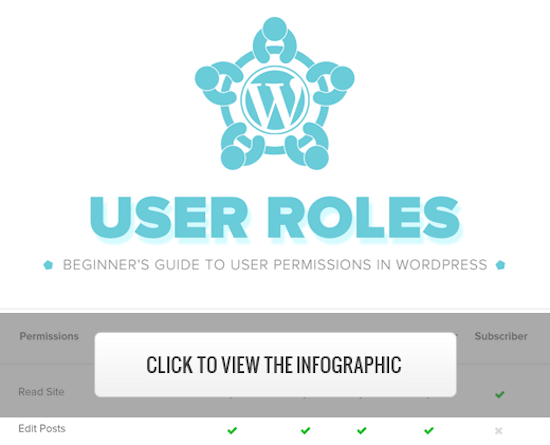
Ya da isterseniz, her bir kullanıcı rolünün dökümünü ve neler yapabileceklerini görmek için okumaya devam edin.
1. Yönetici Rolü
Normal bir WordPress web sitesinde, yönetici rolü en güçlü kullanıcı rolüdür. Yönetici rolüne sahip kullanıcılar yeni gönderiler ekleyebilir, herhangi bir kullanıcının gönderilerini düzenleyebilir ve bu gönderileri silebilir.
Ayrıca, eklentileri ve temaları yükleyebilir, düzenleyebilir ve silebilirler.
En önemlisi, yönetici kullanıcılar kullanıcı ekleyip silebilir ve parolaları da dahil olmak üzere mevcut kullanıcılar hakkındaki bilgileri değiştirebilir.
Bu rol site sahipleri için ayrılmıştır ve WordPress web sitenizin tam kontrolünü size verir.
Çok kullanıcılı bir WordPress sitesi çalıştırıyorsanız, yönetici kullanıcı rolünü kime atadığınıza çok dikkat etmeniz gerekir.
Yönetici Erişimini Bir Geliştirici ile Paylaşabilir miyim?
Deneyimlerimize göre, aynı barındırma hesabı altında bir hazırlık web sitesi oluşturmak biraz daha güvenlidir. Geliştiricilerin kodlarını test etmek için aynı web barındırma ortamına sahip olmalarını sağlar, ancak canlı web sitenizde herhangi bir şey yayınlama hakkı yoktur.
Alternatif olarak, aynı barındırma hesabı altında boş bir web sitesini üzerinde çalışmaları için geliştiricilerle paylaşabilirsiniz. Bu şekilde, web sitenizde depolanan verilere erişimleri olmayacaktır.
Daha fazla bilgi için yönetici erişimini eklenti geliştiricileriyle paylaşma hakkındaki makalemize bakın.
2. Editör Rolü
WordPress’te editör rolüne sahip kullanıcılar, web sitenizin içerik bölümleri üzerinde tam kontrole sahiptir.
Başkaları tarafından yazılanlar da dahil olmak üzere sitedeki herhangi bir gönderiyi ekleyebilir, düzenleyebilir, yayınlayabilir ve silebilirler. Bir editör ayrıca yorumları denetleyebilir, düzenleyebilir ve silebilir.
Editörler site ayarlarınızı değiştiremez, eklenti ve tema yükleyemez veya yeni kullanıcı ekleyemez.
3. Yazar Rolü
Yazar rolüne sahip kullanıcılar kendi gönderilerini yazabilir, düzenleyebilir ve yayınlayabilir. Ayrıca, daha önce yayınlanmış olsalar bile kendi gönderilerini silebilirler.
Yazarlar gönderi yazarken yeni kategoriler oluşturamazlar, ancak mevcut kategoriler arasından seçim yapabilir ve gönderilerine etiket ekleyebilirler.
Yazarlar, incelenmeyi bekleyenler de dahil olmak üzere yorumları görüntüleyebilir, ancak hiçbir yorumu denetleyemez, onaylayamaz veya silemezler.
Site ayarlarına, eklentilere veya temalara erişimleri yoktur, bu nedenle nispeten düşük riskli bir kullanıcı rolüdür. Bunun tek istisnası, kendi yayınladıkları gönderileri silebilmeleridir.
4. Katılımcı Rolü
Katılımcı rolüne sahip kullanıcılar yeni gönderiler ekleyebilir ve gönderilerini düzenleyebilir, ancak herhangi bir gönderi yayınlayamazlar.
Yazı yazarken mevcut kategoriler arasından seçim yapabilir ve etiketlerini oluşturabilirler.
Katılımcı rolünün en önemli dezavantajı, dosya yükleyememeleridir, bu nedenle gönderilerine resim ekleyemezler.
Katkıda bulunanlar ayrıca tüm web sitesi yorumlarını görüntüleyebilir, ancak yorumları onaylayamaz veya silemezler.
Son olarak, web sitesi ayarlarına, eklentilere veya temalara erişimleri yoktur, bu nedenle sitenizdeki hiçbir ayarı değiştiremezler.
5. Abone Rolü
Abone rolüne sahip kullanıcılar WordPress sitenizde oturum açabilir, kullanıcı profillerini güncelleyebilir ve parolalarını değiştirebilir.
WordPress yönetici alanınızda yazı yazamaz, yorum görüntüleyemez veya başka bir şey yapamazlar.
Bu kullanıcı rolü özellikle bir üyelik siteniz, çevrimiçi mağazanız veya kullanıcıların kaydolup giriş yapabileceği başka bir siteniz varsa kullanışlıdır.
Ziyaretçileriniz için özel bir oturum açma deneyimi oluşturmak istiyorsanız, WordPress’te ön uç oturum açma sayfası ve widget’ları ekleme hakkındaki kılavuzumuza bakın.
Bonus: Süper Yönetici Rolü
Bu kullanıcı rolü yalnızca WordPress çoklu site ağında kullanılabilir.
Süper yönetici kullanıcı rolüne sahip kullanıcılar çoklu site ağına site ekleyebilir ve silebilir. Ayrıca eklentiler ve temalar yükleyebilir, kullanıcılar ekleyebilir ve WordPress çoklu site kurulumunda ağ genelinde eylemler gerçekleştirebilirler.
Bunu ağdaki her siteye yönetici erişimine sahip olmak gibi düşünün.
WordPress’te Mevcut Kullanıcı Rolleri ve İzinleri Nasıl Özelleştirilir?
Varsayılan WordPress kullanıcı rolleri, çoğu WordPress web sitesi ve blogu için çalışacak özelliklere sahiptir.
Örneğin, bir dergi web sitesi işletiyorsanız, ‘Editör’ rolü kıdemli personele atanabilir, ‘Yazar’ kullanıcı rolü genç yazarlar için olabilir ve ‘Katkıda Bulunan’ rolü konuk yazarlar için olabilir.
Ancak bazen, web sitenizin özel ihtiyaçlarını karşılamak için role atanan izinleri ve yetenekleri özelleştirmek isteyebilirsiniz.
Kullanıcıların gönderilerini yayınlamalarına izin veren ve aynı zamanda yayınlanan gönderilerini silme olanağı sağlayan varsayılan yazar rolü gibi, bu durumda yazarların gönderilerini silmelerine izin veren özelliği kaldırmak isteyebilirsiniz.
Yorum moderatörü kullanıcı rolü eklentisi gibi web sitenize belirli roller ekleyen bazı eklentiler vardır.
Ancak WordPress kullanıcı rollerinizi özelleştirmenin en kolay yolu Members eklentisini kullanmaktır. Web sitenizde kullanıcı rolleri oluşturmanızı, yönetmenizi ve değiştirmenizisağlar .
Yapmanız gereken ilk şey eklentiyi etkinleştirmek ve yüklemektir. Daha fazla ayrıntı için, WordPress eklentisinin nasıl kurulacağına ilişkin adım adım kılavuzumuza bakın.
Etkinleştirmenin ardından, WordPress yönetici panelinizde ‘Üyeler’ adında yeni bir menü öğesine sahip olacaksınız.
Üyeler ” Roller bölümüne gitmeniz ve düzenlemek istediğiniz kullanıcı rolüne tıklamanız gerekir.
Bu örnekte, ‘Yazar’ rolünü düzenleyeceğiz, ancak ihtiyaçlarınız için en iyi rolü seçebilirsiniz.
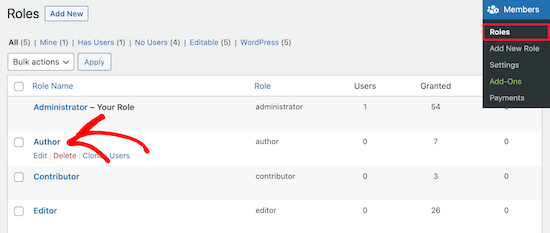
Bu sizi, söz konusu rol için yetenekleri tamamen özelleştirebileceğiniz bir ekrana getirir.
Rol için bir yeteneği kaldırmak için ‘Reddet’ kutusunu işaretleyin. Yeni bir yetenek eklemek istiyorsanız, ‘Ver’ kutusunu işaretleyin.
Burada, Yazıları Sil kullanıcı özelliği için ‘Reddet’ kutusunu işaretleyeceğiz.
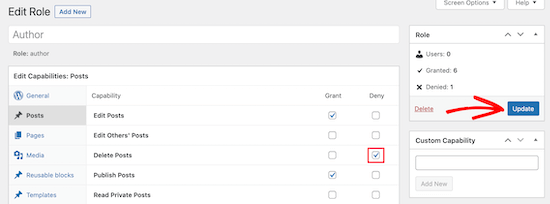
Kullanılabilir bir rol için bir kutuyu işaretlemezseniz, o kullanıcı bu yeteneğe sahip olmayacaktır.
Rolünüzü özelleştirmeyi tamamladıktan sonra ‘Güncelle’ düğmesine tıklayın.
Yaptığınız değişiklikler, bu role sahip tüm mevcut kullanıcılara ve rolün atandığı tüm yeni kullanıcılara otomatik olarak uygulanacaktır.
WordPress’te Özel Kullanıcı Rolleri Nasıl Oluşturulur?
Yapabileceğiniz bir başka şey de WordPress’te benzersiz yetenek setlerine sahip tamamen özel kullanıcı rolleri oluşturmaktır.
Bunu yapmak için yukarıdaki eklentinin aynısını kullanacaksınız.
Basitçe Üyeler ” Yeni Rol Ekle‘ye gidin ve yeni rolünüze bir isim verin.
Örneğin, belirli izinler verilmiş bir WordPress geliştiricisine verebileceğiniz bir geliştirici rolü oluşturabilirsiniz.
Sol taraftaki sütunda mevcut yeteneklerin listesini içeren farklı bölümler vardır. ‘Görünüm’ sekmesini seçeceğiz ve ardından temaları düzenlemek, yüklemek ve güncellemek için yetenekler ekleyeceğiz.
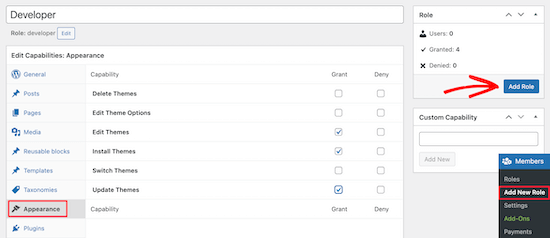
Bundan sonra, kullanıcı rolünü kaydetmek için ‘Rol Ekle’ düğmesine tıklayın.
Ardından, yeni bir kullanıcı oluşturabilir ve ona yeni kullanıcı rolü atayabilirsiniz.
Bunu yapmak için Kullanıcılar ” Yeni Ekle ‘ye gidin ve yeni kullanıcı bilgilerinizi girin.
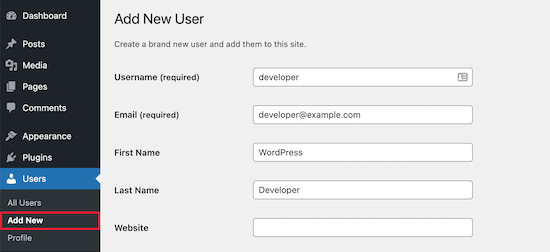
Ekranın alt kısmında bir ‘Kullanıcı Rolleri’ bölümü göreceksiniz.
Şimdi, yeni kullanıcıya atamak istediğiniz kullanıcı rolleri için kutuları işaretleyebilir ve ardından ‘Yeni Kullanıcı Ekle’ düğmesine tıklayabilirsiniz.
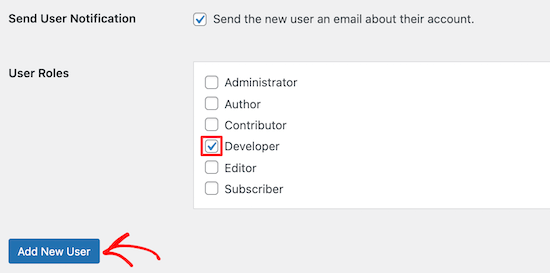
Şimdi, yeni bir özel WordPress kullanıcı rolü oluşturdunuz ve bunu yeni bir kullanıcıya atadınız.
Daha fazla ayrıntı için WordPress’e yeni kullanıcı ve yazar ekleme kılavuzumuza bakın.
Yalnızca yorumları denetlemek için bir WordPress kullanıcı rolü oluşturmak istiyorsanız, blog kullanıcılarının WordPress’te yorumları denetlemesine nasıl izin vereceğinize ilişkin kılavuzumuza bakın.
WordPress Kullanıcı Rolü Yönetimi Hakkında İpuçları ve Öğreticiler
WordPress web sitenizde kullanıcı rolü yönetimini nasıl daha etkili bir şekilde uygulayabileceğinizi merak ediyorsanız, bu ek kaynaklar size yardımcı olabilir.
- WordPress için Kullanıcı Yönetimi Eklentileri (Ücretsiz + Ücretli)
- WordPress’te Editörlerin Yalnızca Belirli Sayfaları Düzenlemesine Nasıl İzin Verilir?
- WordPress’te SEO Editör Rolü Nasıl Eklenir?
- WordPress’te Başarılı Girişten Sonra Kullanıcılar Nasıl Yönlendirilir
- WordPress’te Yazarları Belirli Kategorilerle Kısıtlama
Bu makalenin kullanıcı rollerini ve izinlerini anlamanıza yardımcı olduğunu umuyoruz. Ayrıca, yazarların gönderileri silmesini nasıl engelleyebileceğinize ilişkin kılavuzumuzu görmek veya yazarları kendi gönderileriyle sınırlandırmaya ilişkin eğitimimize göz atmak isteyebilirsiniz.
If you liked this article, then please subscribe to our YouTube Channel for WordPress video tutorials. You can also find us on Twitter and Facebook.





Mrteesurez
This is a detail article that nailed out all what user roles entail and give best practices to assign each to specific users.
My question:
By default, Does a contributor role can see an admin bar ?
I know of athour role.
WPBeginner Support
Unless you disable it for the user role, all user roles would see the admin bar when logged in.
Admin
Jiří Vaněk
I need to add a user to the website who will only have specific rights to what he can do on the website and what he must not have access to. Thank you for the instructions on how to create exactly such a user in WordPress. It saved me a lot of time looking for instructions on how to achieve this.
Muhammad Afzal Qureshi
Very nice explain in detail, I have a great experience after reading out.
WPBeginner Support
Glad you found our article helpful!
Admin
Waqar
Your blog is really awesome, especially when ever I need to learn something about WordPress in deep dive.
WPBeginner Support
Glad you find our content helpful!
Admin
Jen
Hi WPB, how many “admin” roles can a website have? On my site, the original admin has full rights. But new admin usernames don’t. Is that normal?
WPBeginner Support
You can have as many admin users as you like on a WordPress site, if you do not have the default admin privileges then either a plugin may have modified the privileges as the most common reason.
Admin
Sam
Hi – I’m wondering if I can set a default for subscribers that doesn’t allow them access to the dashboard. I have subscribers through a free online course. I want to automatically eliminate the dashboard access so I don’t have to manually uncheck the box “Show Toolbar when viewing site ” Is there a way to do that?
WPBeginner Support
If you only want to hide the admin bar then we have a guide below that for hiding it:
wpbeginner.com/wp-tutorials/how-to-disable-wordpress-admin-bar-for-all-users-except-administrators
We also have a guide for redirecting users after they log into your site below that can help achieve what you’re looking for:
https://www.wpbeginner.com/plugins/how-to-redirect-users-after-successful-login-in-wordpress/
Admin
Tammy
What role is suggested if you want someone to be able to view/download the analytics of a woocommerce site but not be able to change and/or update the content of the site otherwise? Do the basic roles cover that or is that a custom role?
WPBeginner Support
You would likely need to create a custom role for that functionality
Admin
LDB
Why do all articles on user permissions for WordPress never talk about what can be done with ‘pages’?. Seems like such a glaring omission from these articles. Am I missing something? Why do no articles not give info about permission related to building and editing pages?
WPBeginner Support
If you take a look at the infographic we cover which roles can modify pages
Admin
Traci
I am building a website in wordpress for a company. They want a dedicated page for sales or specials but they want to be the one’s handling updating that page each week. Can I give them permission only to post pictures and write add information for the sale items?
WPBeginner Support
It sounds like you would want to set them as the author role and set them as the author of that page.
Admin
Harish
Is there any limitation for user roles count?
WPBeginner Support
No, but you would want to ensure you are not adding roles for every user normally as multiple users can use the same role.
Admin
Maame
Hi,
Is it possible to customize the role of a shop manager? I would like to make some features accessible to them
WPBeginner Support
Yes, we cover the default roles in this guide but more roles can be added or modified
Admin
DannyO
Great writeup. Very close to what I was searching for.
Mine is a bit different,
I have a custom made plugin which I want to assign someone to manage the role. He needs to be entering data on a daily basis in dashboard of this custom plugin. But under the Type-Specific Capabilities, I dont see the name of this plugin. How can I achieve this then, when I cant see the custom plugin name?
WPBeginner Support
You would want to reach out to the plugin’s creator for what permissions are required to be able to use your plugin.
Admin
Katherine
Hi! I work for a site and I’m was assigned Editor. But for some reason, I can’t delete drafts, published articles, or media from Gallery that aren’t mine. The Trash/Delete option just isn’t anywhere on-screen. Is there anything I can do?
WPBeginner Support
You would want to reach out to the admin of the site to ensure there haven’t been any changes to the permissions for your role.
Admin
luka sheklashvili
Hi,
We have a website where is possible to buy food
We have customers and also we have accountant
which premmision will be best for accountant to do his/her work
we are using woocomerce platforme of ecomerce
WPBeginner Support
You would want to take a look at the default WooCommerce roles added and you can add or modify the role depending on the access you want to give.
Admin
Kshitij Gajam
Hi,
Thanks for the great article! it is neatly structured and presented.
I would like to know is it possible to restrict access up to 3 blogs for users who dont subscribe to the website. Only after subscribing they get full access. If yes, how can I do it? Is there a plug in or I have to code?
WPBeginner Support
For what you’re looking for, you would want to take a look at membership plugins below and you would need to reach out to the support for what you’re wanting to use for if they have that available.
https://www.wpbeginner.com/plugins/5-best-wordpress-membership-plugins-compared/
Admin
Felicia Kay
I have recently started a new job with a local law firm and we have purchased a form building tool for our WordPress site. My role permissions have been set to Editor, am I able to access it as an editor to build the new form(s) we need?
WPBeginner Support
It would depend on the specific plugin. If you reach out to the plugin’s support they should let you know what permissions are needed for using the plugin
Admin
lynda
I have been a WordPress user for many years and decided several months ago to combine two blogs. At that time I added the user name of the other blog as a user on my primary blog. Now that second user appears as the author of posts. It appears as the writer of replies to comments. How do I change this?
WPBeginner Support
If you do not want your additional user to be on the site you can delete that user and attribute all of their content to your a different user
Admin
Maude
Hi, do you know if there is a way to create a user who will have access to everything, but can edit nothing. I want to show someone how my website is built so we can talk about it, but I want to be sure he can’t mess anything up.
WPBeginner Support
That would heavily depend on your site and the plugins you are using, you may want to send screenshots or share screens for what you are wanting.
Admin
Jerusha
Hi, I have just started my blog. And installed a new theme. My site is not even live yet … it still had the ‘coming soon” page, however today I discovered I have 308 subscribers under the ‘user’s title on my dashboard… how is that possible?
WPBeginner Support
Your site may be allowing user registration, for more on that you would want to take a look at our article here:
https://www.wpbeginner.com/beginners-guide/how-to-allow-user-registration-on-your-wordpress-site/
Admin
Imran
And what if a disgruntled author goes to “edit” her post and then removes all the content and then click on “update” button.
This would be a rare case but possible even if you disallow her to “delete published” posts.
WPBeginner Support
If you are concerned about that, you could disable the ability to edit published posts
Admin
Segun Wonda
Hello, thank you for this great article.
I have a question please.
After modifying my author role to stop author from deleting their own post with this plugin, will the modification still be active when I disable or delete the plugin?
WPBeginner Support
Yes, your changes should still be active when you remove the plugin.
Admin
sam thandi
i was searching for one of your articles in which you showed how to create user like Editorial Staff can you please give me link to that article. thanks
WPBeginner Support
It would depend on what you mean. If you’re wanting more editorial options you could take a look at our article here: https://www.wpbeginner.com/plugins/how-to-improve-your-editorial-workflow-in-multi-author-wordpress-blogs/
If you wanted to hide the author’s name we have our article here:
https://www.wpbeginner.com/wp-themes/how-to-remove-author-name-from-wordpress-posts/
Admin
Pablo
I can see that there are more user categories now, in addition to the 5 mentioned here. Participant, Moderator, Spectator… Cant see the permissions for these! Any ideas where to find them?
WPBeginner Support
If you have other plugins that add user roles those would likely be why you have the extra roles
Admin
Infoneter
Nice and useful information. thanks
WPBeginner Support
You’re welcome
Admin
Kirk Bullen
Great post.. And great site. It’s my ‘Go To’ site, for everything I need, and have learnt so much.
What I want to do, is create a Movie Mod User. So that they can Add Movies/Shows. But I don’t want to give all Admin permissions. They would only require to use the Plugin used to add these Movies/Shows. All it.would require them to do, is use the Import Movie/Show. Then once added, have the ability to edit the Movie/Show. So that they can add the Movie/Show Collection/Genre.
Is there a plugin available that you know of, that gives permissions to use selected Plugin Admin abilities? I have tried Editor User. But it doesnt show the ‘Import’ option.
Any advise is greatly appreciated.
WPBeginner Support
It would depend on what you are using to import the movies, if it is a plugin you should be able to reach out to the plugin’s support for what permission is required to import the movie/show.
Admin
Steveo
Users >> Capabilities does not exist. Got another idea?
WPBeginner Support
You may want to ensure that the plugin was activated successfully on your site.
Admin
sultan haider
I have school chains in multiple cities and i want to each school have
their login and password and add students in own schools records and
admin have access all schools records.
Its possible with wordpress or not.
WPBeginner Support
It is possible but you would likely need to have a custom plugin created to do something that specific.
Admin
Tony
Suggest you use multisite capability, each school can have their own subdomain.
Emzee
How to check what permissions I have as a user on wordpress site please? Sorry am a beginner?
WPBeginner Support
Hi Emzee,
Using the capability manage enhanced you can see what permissions a user has on your site.
Admin
shubhangi
Great post now i can ad more author without confusion thanks friend
Mithilesh Yadav
How to send notification mail by Guest User in WordPress
Marianne
Good day!
Thanks for the explanation. I was wondering is there also a date stamp when the user has registered?
regards,
Kagan
i am using wholesale plugin. we want open manuel order from order woocommerce dashboard
But when i add product wholesale prices are not shown. is it possible to make this wtih user roles plugins. if so which one should we use
thank you
chintan
Hi i want make a two type of login page first is customer and second is Service provider (like a amazon seller).
service provider uplode it’s services , and it can edit it’s services.
how i do that?
beth
Hi. I created some new users but they have yet to receive their email notification. How long does it take for that to be generated?
LaVonne Carlson
Is it possible to setup a user with permission to edit only a particular page? I’m running a website for a Boy Scout troop, and I want the boys to be able to upload and rearrange photos on the gallery page, but not make any other changes to the site.
Gulfam
I’ve also problem related to your question, want to allow user only on specific plugin and page to post things.
Fahad Rafiq
How can we remove underscore from users name in wordpress users tab?
Like if name entered is First Second, it will appears as First_Second.
Any fix.?
John
Whenever my writers try to past an iframe into their stories it vanishes when saving. From a little bit of testing this occurs up to Editor level which also gives publishing ability — which I don’t want them to have.
I’ve got both adminimize and user role editor installed. Staff writers have a custom user role editor setting of Staff Writers.
How can I overcome this limitation on inserting iframes?
Thank you
WPBeginner Support
Hey John,
The capability to add iframes is part of unfiltered_html capability. However, allowing user roles the ability to add unfiltered html is too risky and not recommended. You should look for other ways to manage this. For example, if this iframe embed is from a third party service provider, they they might already have a WordPress plugin.
Admin
John
Thank you. Ordinarily I would agree. But these are inhouse writers who need this capability. The most common is Facebook video embeds getting the iframe from Embedded Video & Live Video Player.
We also embed YouTube and other video in the body of the stories often and this explains why the html table that has been prepared for them to use by simply replacing the URL doesn’t work.
The rest of what the different level of access – editor, copy editor, photo editor, contributor, and staff writer can see and access is regulated using adminimize and user role editor.
What is the risk of giving unfiltered html access to inhouse staff?
Thank you
WPBeginner Support
Hey John,
With unfiltered html capability, users will have the ability to add malicious code which could get executed as soon as the post content is saved.
John
Ok. Thank you. That won’t be an issue in this instance. But very useful to know.
Akhil
Is it possible to delete a post by another author.?
WPBeginner Support
Hey Akhil,
If you are an administrator or editor on that site, then yes you can delete posts created by another author.
Admin
Jake
I am not getting a lot of “email subscribers” via the subscribe widget to my blog but I do receive a lot of “New user registration” notifications from WP of people that are set up as their user role as “subscribers” and so my WP admin has a list of these people and their email addresses.
As far as I can tell, when I create a new post, no one with the user role “Subscriber” is being notified. Why else does WP give me their email address if not to notify them? Perhaps I am doing something wrong? How do I notify the hundreds and hundreds of people in this list?
WPBeginner Support
Hi Jake,
Please see our guide on how to add email subscriptions to your WordPress blog.
Admin
Imtiaz Ahmed
hi, I have many Editors on my website, how I can strict, I mean editors are not able to edit Admin post. I want this on my website
Regards:
Imtiaz Ahmed
WPBeginner Support
Hey Imtiaz,
The editor user role gives users permission to edit any posts. You should change their user role to author or contributor. You can also edit permissions of a user role or create new user roles using plugins.
Admin
Gary Wicks
I have a question if I have 300 subscribers what does that mean? Does it mean people subscribed to make a comment? I have no idea where these came from as I only have a few actual comments posted. Does this mean they were all spammers that Akismet software rejected? So the comments did not show but they are all in my users list as subscribers to make comments?
Or is this rss feed or what is it?
Steve Root
The role attribute selection on my theme has both an Allow and a Deny column. If a particular attribute is only enabled when checked what is the purpose of the Deny column (twenty-sixteen)?
deppak
Hi there,
Great post!
I created a custom role cloning the “administrator”, is it possible for administrators to change between the two? I can see the administrator can change all others’ role, but can it change its own through the back-end dashboard/menu?
Thanks!
Anne Cohen
Hi. Thank you for the post! Very helpful, but one more question….
Can Contributor writers DELETE their articles when they’re published?
What about when they’re pending?
Let’s say they had a change of heart? I just noticed a contributor alter an article that I was already editing/pending. I didn’t think that was possible.
Abhiney
Hi,
I am facing issues with the user creation. I am looking to create an editor for my website but despite deactivating all plugins, changing passwords etc,for the new user – when I try to login in through the ‘New User’ credentials it says – “Sorry, you are not allowed to access this page.”
Can you please help.
Debbie N.
Can I give permission to use a backup plugin but not other plugins? I see you can add more capabilities but I can’t figure out how to set it up for that. Thanks for any help.
Obed Aikins
Hi, nice post, very useful. i’m a college student developing a site for publishing hostels information and also book into it using wordpress. i want to create custom agent/landlord roles in WP. please help
Stuart
Users with the subscriber user role can login to your WordPress site and update their user profiles. They can change their passwords if they want to. They cannot write posts, view comments, or do anything else inside your WordPress admin area.
This user role is particularly useful if you require users to login before they can read a post or leave a comment.
I don’t understand this. So if a subscriber is logged in can they or can’t they comment on a post?
WPBeginner Support
Yes they can comment on a post.
Admin
Alan Jordan
This was really helpful. Thank you.
Jez Butler
Great descriptions – thanks! Is there any way to set an Administrator role for individual sites on a multisite install? TIA, Jez